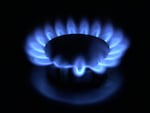A new report shows Oregon’s largest gas utility is not on track to meet the state’s climate goals despite doubling down on using renewable natural gas to offset its carbon emissions.
NW Natural, a gas utility that serves more than 2.5 million people across the Pacific Northwest, submitted an updated version of its Renewable Natural Gas Compliance report Friday. The report shows the utility’s renewable natural gas volume was just 0.15% of the company’s Oregon sales in 2022. That’s a far cry from the utility’s goal of 3% in 2022, according to their Integrated Resource Plan. Friday’s report also reveals that the utility’s use of renewable natural gas declined in 2022, down from 0.21% in Oregon sales in 2021.
Renewable natural gas, or RNG, is a type of biogas made from decomposing organic matter. RNG is often produced by capturing byproducts from landfills, livestock operations or wastewater treatment. It’s also mostly made up of methane — a greenhouse gas that is 86 times more potent at trapping heat in the atmosphere than carbon dioxide over a 20-year period. NW Natural has pointed to this gas as a way it can start to substantially reduce its greenhouse gas emissions without turning to electrification.

A blue flame burns on a natural gas stove.
Cassandra Profita / OPB
David Roy, a spokesperson for NW Natural, said the RNG market is “increasingly competitive” but the utility’s percentage of RNG delivered to customers is expected to increase about five times over this year.
“We are evaluating the timing of some of our RNG purchases, but not whether we pursue RNG,” he said in an email statement. “RNG will be required in order to meet our compliance targets over time.”
Roy said it takes time to get renewable natural gas projects developed and online. He said despite being halfway through the year, the utility is close to meeting its goal for 2023. That information will not be available until 2024.
“We are fully committed to meeting our climate goals,” Roy said. “There is ample RNG resource out there for RNG to be a meaningful part of our decarbonization strategy.”
As the climate crisis continues to worsen, with major parts of the country currently experiencing extreme heat and flooding, the pressure to move away from fossil fuels is becoming more urgent. For NW Natural, that pressure comes from complying with the state’s Climate Protection Program, which requires utilities to reduce greenhouse gas emissions by 90% by 2050. But acquiring enough renewable natural gas to offset carbon emissions is challenging, and a strategy that has received scrutiny from climate advocates and groups who want Oregon and its utilities off of fossil fuels.
Charlie Spatz is a researcher with the Energy and Policy Institute, a watchdog organization that counters misinformation by fossil fuel and utility interests. He said NW Natural was one of the first gas utilities in the nation to push for renewable natural gas as a solution to decarbonize.
“It’s really important for us to see if they’re acquiring renewable natural gas, where it’s coming from, and if it’s even close to the magnitude that it needs to come online to reduce their emissions,” he said.
Spatz said the utility has pushed hard against electrification. Having this current data available is important, he added, not only to see if NW Natural is meeting its goals but also to show if renewable natural gas is worth pursuing.
Last month, the Oregon Public Utility Commission told NW Natural it needed to revise parts of its Integrated Resource Plan, to meet the state climate goals. In that document outlining how the utility plans to meet Oregon’s energy needs at a fair price, NW Natural said it was seeking to acquire millions of dekatherms, a unit of energy, of renewable natural gas by 2025 that would represent at least 5% of Oregon sales in that year.
For comparison, NW Natural acquired only 120,847 dekatherms in 2022, to reach a total volume of 0.15%.
Utility commissioners pushed the NW Natural last month to make more realistic efforts toward clean energy. Commissioners also said the utility did not adequately consider the Community Climate Investment program, which allows the company to buy greenhouse gas credits at a cheaper rate than renewable natural gas and reduce emissions in the state.
NW Natural and Oregon’s other two gas providers — Avista and Cascade Natural Gas — have also filed a lawsuit to roll back the state program that mandates the climate goals.
Critics noted that the small amount of renewable natural gas used by NW Natural is largely coming from beef processing facilities in Nebraska.
“They made a big deal about sourcing that gas from within Oregon,” Spatz said. “Even from the report that was aggressively redacted, we just don’t see any of that gas being sourced in state.”
NW Natural’s Roy said there are multiple sources of the gas in Oregon but buying it elsewhere has been cheaper.
“NW Natural is currently working to develop several RNG projects itself in-state, but those projects are not currently flowing gas,” Roy said.
Bob Jenks, the executive director for Oregon’s Citizens Utility Board, an organization that advocates for customers in the state, said NW Natural is not close to the kind of schedule it would need to meet the state climate goals.
“What this really indicates is you’ve got environmental regulations that the company is not on its path to meet,” he said.
He said the open question now is whether state regulators would fine the company for missing its climate goals, and how that would flow on to the customers.



